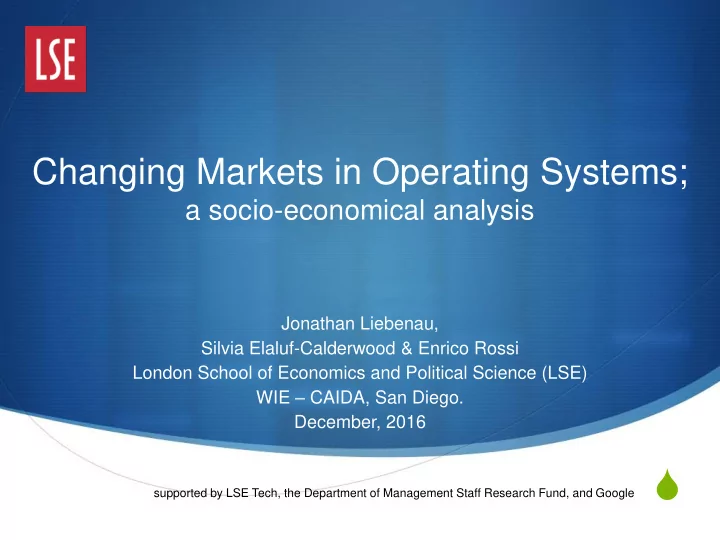

Changing Markets in Operating Systems; a socio-economical analysis Jonathan Liebenau, Silvia Elaluf-Calderwood & Enrico Rossi London School of Economics and Political Science (LSE) WIE – CAIDA, San Diego. December, 2016 S supported by LSE Tech, the Department of Management Staff Research Fund, and Google
Presentation contents S Exploratory work & motivations S Project research questions & novelty approach S Establishing relations of power structure in OS S Platforms and competition S New roles of ownership & control (platform analysis & data ownership/control) S Shifting boundaries S Preliminary conclusions; future research
Exploratory work and motivations for this research S Our main purpose is to assess the character of OS market to better understand characteristics & consequences of fragmentation. S We consider in our analysis effects on trade & innovation & on the significance for the architectures of networks in the digital economy.
Three core research questions S Where does control reside in an ecosystem of devices, software & services? S What happens when we distinguish between control & ownership S What is the significance of application & protocol standards in a heterogeneous network? S What is the significance of application technologies with regard to use?
Novelties in research S Boundaries between the standard roles of consumption and production are blurred in the consideration of operating systems. S Novel concepts of ownership apply. S The decoupling between services and physical supports raises issue of control rather than ownership.
Establishing structures of power in OS 1 2
Establishing structures of power in OS 3 4
Platforms & competition (i) Modularity in production S Identifies the set of elements (modules) interconnected among each other (& compatible), located in the network core S These are therefore in producers’ domain (ISP, VPN, network providers in general, etc.) S Two characteristics of this type of modularity S Producers own the elements (or modules); S These elements are always inputs in the production process (or are part of the production process); they are used to deliver some type of service to end users
Platforms & competition (ii) Modularity in consumption S Identifies the set of elements (modules) interconnected among each other (& compatible) located at the edges of the network, i.e. in the domain of the end user S More ambiguous than production; (ownership boundaries at the edge may be blurred) S These elements are mainly outputs of a production process: they are sold to the end user by whoever produces them
Platforms and Competition (iii) A current research problem concerns the interpretation of the feedback, identified as question marks
New roles of ownership & control S Control, access & ownership in the physical layer in platforms S Backbone networks, internet exchanges, private links, fiber and copper networks, access exchanges, access points S Control, access & ownership of intangible assets: S Ownership of data among various actors cooperating (or competing) S Relationships with the OS provider
Internet Platform Analysis Infrastructure Service Operational OS : Android, iOS Social Network Embedded content apps Provider: cable or Or other mobile or fixed operative Platforms embedded on Within social networks mobile operator System an operation OS Access can be performed Control of physical Control to social Control of digital access points to at level 2 or 3 access points and Platform, rules exist, dominance of networks for sharing of management of Own platform rules and own data content within the Invisible distinction of backbone links Application code rules. walled domain of the usage for level 1 platform And flexibility to swap between OS Multi OS platform Subject to variable rules compatibility E.g. Facebook, Twitter, Snapchat, etc E.g. YouTube, Netflix, Souncloud, Spotify
Shifting boundaries: Analysis example 1. The boundary defining ownership: who owns what & where; 2. The boundary defining the relationship between (tangible/intangible) platform & services that can be obtained: who controls what & where; 3. The boundary separating consumption from production: who is selling something to whom & where.
Preliminary observations S Where the end user ownership/control of the various modules is located vis-à- vis the producers’ ownership/control of the same elements. S Where the decoupling between the underlying platform support is located vis-à-vis the functionality set (or service set) supported by it. S Whether the service flows are all pointing down-ward (as in a standard setting where the end user at the edges is just consuming what is offered), or whether the end user is actually operating as a producer, thus using its modules and mediums in order to pipe further services (applications, data or information) into the network in a descentralized way.
Further research S Mapping triggers to understand the shifting in boundaries for regulatory, technological, & social factors. S Building a model that can be tested with economic variables S Testing hypothesis for law & regulatory implications S Links to Open Source analysis is a partial view
Extra Slides
Data Ownership/Control • Network layer • OS layer • Social platforms • Content • Control of ID • Identification • Identification • Identification • Authentication • Location based • Location based user (SIM) • Authentication • Encryption services services • Encryption • Access to • Access to (software) • Location based (hardware) information in information in layers • Location based services layers 1 and 2 1 - 2 - 3 • Gateway for • Profiling and • Profiling & privacy services • Monetary • Meta data accessing privacy • Meta data • Personal data transaction information faster • Personal data • White box verification and or with profile • White box processing preferences interoperability with • All types of (databases) interoperability platform OS • Unique protocols • Monetary protocols to with platform OS • Monetary manage traffic for distribution of transactions • High reliability (networks OS) content transactions • Net neutrality • Strong Inter service • Traffic preference operability rules ideal
Recommend
More recommend